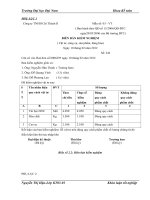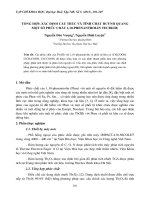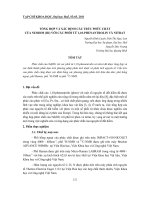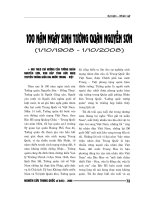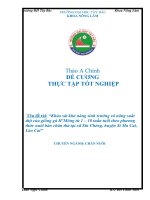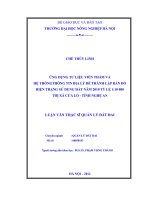2138 article text 2412 1 10 20151031
Bạn đang xem bản rút gọn của tài liệu. Xem và tải ngay bản đầy đủ của tài liệu tại đây (183.64 KB, 8 trang )
Journal of Phytology 2010, 2(6): 61–68
Phytophysiology
ISSN: 2075-6240
Available Online: www.journal-phytology.com
REGULAR ARTICLE
EFFECT OF SEAWEED LIQUID FERTILIZER ON THE GROWTH,
BIOCHEMICAL CONSTITUENTS AND YIELD OF TAGETES
ERECTA, UNDER FIELD TRIAL
1Department
2Centre
S. Sridhar1* and R. Rengasamy2
of Botany, Govt. Arts College, Thiruvannamalai- 606 603, Tamil Nadu, India
for Advanced Studies in Botany, University of Madras, Chennai-600 025
Tamil Nadu, India
SUMMARY
The efficacy of Seaweed Liquid Fertilizer of different concentrations obtained from green
seaweed Ulva lactuca was assessed on the growth, pigments, total chlorophyll, total
protein, total carbohydrate and total lipid and the yield of a flowering plant Tagetes erecta.
The combined effect of 1.0% SLF of U. lactuca with different proportions of
recommended rate of chemical fertilizers was also made on the test plant. Among the
concentrations, plants that received with 1.0% SLF and 50% recommended rate of
chemical fertilizers showed a maximum growth characteristic, number and fresh weight
of flowers.
Key words: Seaweed liquid fertilizer, Chemical fertilizers, Ulva lactuca, Tagetes erecta, Yield
S. Sridhar and R. Rengasamy. Effect of Seaweed Liquid Fertilizer on the Growth, Biochemical Constituents and Yield of Tagetes erecta, under Field Trial. J Phytol 2/6
(2010) 61-68.
*Corresponding Author, Email:
1. Introduction
Seaweeds as manure dates back to fourth
century as a partial substitute for manure
(Chapman, 1950). Seaweed extracts are being
used as fertilizer to enhance the growth and
yield of certain commercial crops (Bockett
and Van Staden, 1990; Crouch and Van
Staden, 1993; Jeanin et al., 1991 and Rama
Rao, 1991). The value of seaweed as
fertilizers was not only due to nitrogen,
phosphorus and potash content but also
because of the presence of trace elements and
metabolites, similar to plant growth
regulators (Booth, 1969). In recent years the
use of natural seaweed products as
substitutes to the conventional inorganic
fertilizers assumed importance (Crouch and
Van Staden, 1993 and Gangatharan, 1998).
On the basis of these qualities, the seaweed
has been tried in the form of concentrated
extracts, which are being marketed under
different trade names in Western countries
(Stephenson, 1965). Improved mineral
nutrition leads to healthier plants to
withstand better against detrimental attacks
by pest. Heightened resistance to fungal,
bacterial and insect attack has been observed
for a variety of plants treated with seaweed
preparations (Aitken and Senn, 1965;
Aldwoth and Van Staden, 1987; Booth, 1969;
Featonby-Smith and Van Staden, 1983;
Featonby-Smith and Van Staden, 1984 and
Stephenson, 1965).
2. Materials and Methods
Specimen of green seaweed Ulva lactuca
was collected form Mandapam coast, Tamil
Nadu, in 2002. They were washed
thoroughly initially with seawater on the
spot and finally with fresh water in the
laboratory to remove sand particles and
macroscopic epiphytes. They were shade
dried for 4 days, followed by oven dry for 12
h at 60˚C. Then the material was hand
crushed and made as coarse powder using a
mixer grinder. Then the material was taken
for the preparation of Seaweed Liquid
Fertilizer (SLF) as following the method of
Rama Rao (1990). The above algal sample
was added with distilled water in a ratio of 1 :
20 (w/v) and autoclaved at 120°C, 15 lbs/sq.
S. Sridhar and R. Rengasamy/J Phytol 2/6 (2010) 61-68
inch for 30 minutes. The hot extract was
filtered through double-layered cheesecloth
and allowed to cool at room temperature the
filtrate was centrifuged at 10,000 x g for 15
minutes. The supernatant was collected and
considered as the SLF stock. Its concentration
was determined by taking a known volume
of the sample (100mL) and kept in a hot air
oven at 60°C until it showed a constant
weight. A sample SLF was taken for the
estimation of macro and micro elements
(Humphries, 1956) and auxin (Gordon and
Paleg, 1957) and cytokinin (Syono and
Torrey, 1976).
Experimental trail was conducted at
Panchalam near Tindivanam on Tagetes erecta
seedlings were raised in 4m x 3m plot. Thirty
days old seedlings were taken for
transplantation. One or two seedlings were
transplanted along a side of the ridges at 30
cm spacing. For each experiment ten plants
per row was taken.
Application of different concentrations of
SLF viz, 0.25, 0.5, 1.0 and 1.5% as well as
different proportions of recommended rate
of commercial fertilizers: 25%, 50%, 75% plus
1.0% SLF was made on the plants grown in
rows. The plants were irrigated every week.
Application of different concentrations of
SLF was made 100ml/hill by soil drench on 0
day and 30th day after transplantation as
corresponding days of chemical fertilizer
application. The plants were also applied
separately with different proportions of
recommended rate of chemical fertilizers
plus 1.0% of SLF on 0 day and 30th day. The
1.0% SLF was taken and mixed the respective
proportions of chemical fertilizer thoroughly
and distributed equally to 10 plants in a row
(100 ml/hill). The plants without any
application (SLF or chemical fertilizers) were
treated as control I and the plants that
received with 100% recommended rate of
chemical fertilizers treated as control II.
100% recommended rate of chemical fertilizers
Days
0day
30thday
Chemical fertilizers (per ha)
Urea
- 62.5Kg
Super Phosphate - 120Kg
Potash
- 25Kg
Urea
- 62.5Kg
e.g. Urea 6.2g/row applied on 30th day.
Mature seeds of Tagetes erecta were
obtained from the Agricultural depot
Arakkonam.
Thirty day old plants were taken for the
following parameters total plant height,
shoot height, root height (cm), total fresh
weight, shoot fresh weight, root fresh weight,
total dry weight, shoot dry weight, root dry
weight (g) and number of branches. The
Chlorophyll, Chlorophyll a, Chlorophyll b
(Mackinney, 1941), total protein (Bradford,
1976), total carbohydrate (Dubois et al., 1956)
and total lipid (Folch et al., 1957) (mg/g fresh
weight) were also recorded. At the end of
60th day the mature flowers of T. erecta were
picked out and recorded their number and
fresh weight (Kg).
3. Results and Discussion
Tagetes etecta treated with four different
concentrations of U. lactuca SLF 0.25%, 0.5%,
1.0% and 1.5% showed enhanced values on
different physical and biochemical features
than the plant received only water. The crude
extract obtained from Cladophora was found to
be more effective in increasing the length of
main root than Ulva extract on Vicia faba and
appreciable increase in chlorophyll a and
chlorophyll b (El-Sheekh and El-Saiedh, 1999).
Among the treatments the plants that received
1.0% concentration showed a maximum plant
height of 51.0cm, which was more than 54.0%
when compared to control. Further, SLF
treatment increased the number of branches
(Table 1) and concentration of photosynthetic
pigments. At 1.0 % concentration, the plants
contained maximum concentrations of 2.476
mg/g fresh weight of total chlorophyll, 2.021
mg/g fresh weight of chlorophyll a and 0.455
mg/g fresh weight of chlorophyll b. their
increments were more than 41.0%, 42.0% and
37.0% respectively, when compared to control
(Fig.1a).
S. Sridhar and R. Rengasamy/J Phytol 2/6 (2010) 61-68
Table 1: Effect of Ulva lactuca SLF on growth of Tagetes erecta under field trial on 30th day
Parameters
F-value
P-value
Concentrations
UT1
UT2
UT3
UT4
UT5
Total plant height
(cm)
41.87
0.00**
33.20 ± 0.83a
35.40 ± 2.70a
44.40 ± 4.33b
51.00 ± 1.58c
43.40 ± 1.34b
Shoot height (cm)
34.53
0.00**
29.20 ± 1.48a
30.80 ± 2.77a
39.20 ± 3.70b
43.80 ± 1.48c
38.40 ± 1.14b
Root height (cm)
13.51
0.00**
4.00 ± 0.70a
4.60 ± 0.54a
5.20 ± 0.83a
7.20 ± 0.83b
5.00 ± 0.70a
Total fresh weight
(g)
35.98
0.00**
70.42 ± 2.54a
73.74 ± 5.80a
92.82 ± 8.88b
103.74 ± 3.03c
90.68 ± 2.51b
Shoot fresh weight 23.02
(g)
0.00**
61.72 ± 3.44a
64.60 ± 5.72a
82.16 ± 7.71b
92.18 ± 3.03b
84.36 ± 8.72b
Root fresh weight
(g)
6.15
0.00**
8.70 ± 1.09a
9.14 ± 0.84ab
10.66 ± 1.71bc
11.52 ± 0.46c
10.32 ± 0.52abc
Total dry weight
(g)
35.95
0.00**
29.80 ± 2.10a
31.21 ± 4.64a
39.2 ± 7.10b
43.90 ± 2.36c
38.38 ± 1.72b
Shoot dry weight
(g)
33.86
0.00**
26.12 ± 2.82a
27.34 ± 4.57a
34.77 ± 6.17b
39.01 ± 2.43c
35.70 ± 1.84b
Root dry weight
6.14
0.00**
3.68 ± 0.87a
3.87 ± 0.67ab
4.43 ± 1.37bc
4.89 ± 0.36c
2.68 ± 0.42abc
Number of
branches
6.63
0.00**
1.20 ± 0.83a
2.00 ± 0.70a
2.80 ± 1.30ab
4.00 ± 0.70b
2.80 ± 0.83ab
Note:
*
denotes significant at 5% level
denotes significant at 1% level
different alphabets between concentration denotes statistically
significant based on multiple range test (Tukey -HSD test).
**
U - Ulva lactuca T - Treatment
UT1 - Control
UT2 - 0.25 % SLF
UT3 - 0.5% SLF
UT4 - 1.0% SLF
UT5 - 1.5% SLF
Fig. 1a: Effect of different concentrations of Ulva lactuca SLF on the pigments of Tagetes erecta on 30th day
Application of seaweed preparations has
many beneficial effects on plants (Metting et
al., 1990; Norrie and Hiltz, 1999).
Observations in the present investigation
confirm earlier reports showing that the U.
lactuca SLF can improve the accumulation of
S. Sridhar and R. Rengasamy/J Phytol 2/6 (2010) 61-68
total carbohydrate, total protein and total
lipid contents was also found maximum
when the plants received with 1.0% SLF on
marigold. At this condition their increments
were more than 37.0%, 58.0% and 60.0%
respectively (Fig. 1b). The plants that
received with 1.0% U. lactuca SLF showed a
maximum yield of 132 flowers with 1.76 Kg
fresh weight per 10 plants per row when
compared only 93 flowers with 1.24 Kg per
10 plants per row in control (Table 2).
Fig. 1b: Effect of different concentrations of Ulva lactuca SLF on the total protein, total carbohydrate, and total
lipid content of Tagetes erecta on 30th day
Table 2 : Effect of different concentrations of Ulva lactuca SLF on the yield of Tagetes erecta
Concentrations
Number of Flowers/10 plants/a row
Fresh weight of flowers/10 plants /a row
(Kg)
Control
93
1.24
0.25% SLF
110
1.55
0.5% SLF
121
1.70
1.0% SLF
132
1.76
1.5% SLF
125
1.72
Among the treatments the plants that
received with 50% recommended rate of
chemical fertilizers plus 1.0% U. lactuca SLF
showed maximum plants height, fresh
weight, dry weight and number of branches
(Table 3). At this condition accumulation of
total carbohydrate, total lipid and total
protein of the 3rd young leaf was also found
maximum. Further, the concentration of total
chlorophyll, chlorophyll a and chlorophyll b
was increased by 34.0%, 33.0% and 38.0%,
respectively when compared to 100%
recommended rate of chemical fertilizers.
The accumulation of total carbohydrate, total
protein and total lipid content was also
recorded a maximum of 30.9 mg/g fresh
weight, 30.8 mg/g fresh weight and 20.1
mg/g fresh weight, respectively (Fig. 2a, b).
The number of pods per plant and seeds
per pod the treatment with 2 gm of Hypenea
musciformis plus chemical fertilizer yielded
results to any other treatment (Norrie and
Hiltz, 1999). However, in the present study
the marigold plants received with 50%
recommended rate of chemical fertilizers
+1.0% U. lactuca SLF showed a maximum
number and fresh weight of flowers at this
condition, the plants had 142 flowers with
2.6kg fresh weight /10 plants/ row when
compared to only 118 flowers with 1.95 kg
fresh weight/10 plants/row recorded from
S. Sridhar and R. Rengasamy/J Phytol 2/6 (2010) 61-68
100% recommended rate of chemical
fertilizers (Table 4).
Utilization of seaweed as seaweed liquid
fertilizer is one of the excellent means to get
the lost nutrients back to the land.
Application of SLF plays a significant role in
improving the yield of crop plants by about
20-30%. The value of seaweed as fertilizer is
not from the nitrogen, phosphorous, potash
an organic matter but from trace elements
(Booth, 1965, 1969). The analysis of seaweed
extract of U. lactuca revealed that amongst
macronutrient the values of total nitrogen
were maximum followed by potassium,
sulphur,
magnesium,
calcium
and
phosphorus (Sekar et al., 1995). But in the
present study among the macro elements the
value of magnesium (384 mg/L) was highest
followed by potassium (220 mg/L), calcium
(208 Mg/L), nitrogen (24.2 mg/L) and
phosphorus
(20.9mg/L)
and
the
micronutrients Fe- 7.9, mn – Nil, Cl 170.
Table 3: Effect of different proportions of recommended rate of chemical fertilizers + 1.0% Ulva lactuca SLF on Tagetes
erecta under field trial on 30th day
Parameters
F-value
P-value Concentrations
CUT1
CUT2
CUT3
CUT4
CUT5
CUT6
Total plant height
(cm)
40.57
0.00**
34.84 ±
1.82ab
37.28 ± 1.59b 41.80 ± 0.60c 35.38 ±
1.33ab
34.22 ± 1.14b 29.80 ± 1.45a
Shoot height (cm)
35.99
0.00**
29.40 ±
1.49bc
31.64 ± 1.31c 34.86 ± 0.55c 20.58 ±
1.20bc
28.72 ± 1.30b 24.90 ± 1.27a
Root height (cm)
12.10
0.00**
5.44 ± 0.51ab 5.64 ± 0.48ab 6.94 ± 0.58c
Total fresh weight
(g)
39.91
0.00**
72.96 ±
3.84bc
78.10 ± 3.35c 87.60 ± 1.26d 74.14 ±
2.85bc
71.66 ± 2.43b 62.40 ± 3.10a
Shoot fresh weight 35.81
(g)
0.00**
61.58 ±
3.14bc
66.28 ± 2.76c 73.02 ± 1.17d 61.96 ±
2.51bc
60.16 ± 2.75b 52.16 ± 2.68a
Root fresh weight
(g)
11.79
0.00**
11.38 ±
1.10ab
11.82 ± 1.01ab 14.52 ± 1.21c 12.18 ± 0.90b 11.50 ±
0.51ab
Total dry weight
(g)
40.05
0.00**
30.88 ±
3.05bc
33.05 ± 2.67c 37.07 ± 0.97d 31.38 ±
2.27bc
Shoot dry weight
(g)
36.52
0.00**
26.06 ± 2.48b 28.05 ± 2.19b 30.90 ± 0.93c 26.22 ± 1.99b 25.46 ± 1.99b 22.07 ± 2.13a
Root dry weight
11.56
0.00**
4.82 ± 0.88ab 5.00 ± 0.81ab 6.17 ± 0.97c
5.16 ± 0.73b
Number of
branches
6.98
0.00**
3.40 ± 0.54abc 4.20 ± 0.83c
3.80 ± 0.83bc 2.80 ± 0.83ab 2.40 ± 0.54a
Note:
5.50 ± 0.25ab 4.90 ± 0.27a
10.24 ± 0.59a
30.33 ± 1.95b 26.41 ± 2.45a
4.87 ± 0.40ab 4.34 ± 0.46a
denotes significant at 5% level
denotes significant at 1% level different alphabets between concentration denotes statistically significant
based on multiple range test (Tukey -HSD test).
- Ulva lactuca T - Treatment C - Chemical fertilizer
- 100% recommended rate of chemical fertilizer
- 75% recommended rate of chemical fertilizer + 1.0% SLF
- 50% recommended rate of chemical fertilizer + 1.0% SLF
- 25% recommended rate of chemical fertilizer + 1.0% SLF
- 1.0% SLF only
- Water only
*
**
U
CUT1
CUT2
CUT3
CUT4
CUT5
CUT6
4.60 ± 0.54c
5.80 ± 0.40b
S. Sridhar and R. Rengasamy/J Phytol 2/6 (2010) 61-68
Fig. 2a: Effect of different concentrations of recommended rate of chemical fertilizers + 1.0 Ulva lactuca SLF on the
pigments of Tagetes erecta on 30th day
Fig. 2b: Effect of different concentrations of Ulva lactuca SLF on the total protein, total carbohydrate, and total
lipid content of Tagetes erecta on 30th day
Table 4 : Effect of different proportions of recommended rate of chemical fertilizers + 1.0% Ulva lactuca SLF on the yield
of Tagetes erecta
Concentrations
Number of Flowers/10
plants a row
Fresh weight of flowers/10
plants/a row (Kg)
100% recommend rate of chemical
fertilizers
118
1.95
75% recommend rate of chemical
fertilizers + 1.0% SLF
125
1.76
50% recommend rate of chemical
fertilizers + 1.0% SLF
142
2.60
25% recommend rate of chemical
fertilizers + 1.0% SLF
137
1.93
SLF only
120
1.69
Water only
90
1.25
Fe-7.9, Mn-Nil, Cl-170 and F-0.45 mg/L and Auxin 157 µg/L and Cytokinin 200 µg/L were estimated
S. Sridhar and R. Rengasamy/J Phytol 2/6 (2010) 61-68
Acknowledgements
The authors are extremely thankful to
Prof. N. Anand, and Prof. D. Lalitha Kumari,
former Directors, CAS in Botany for
providing laboratory facilities and also
grateful to the UGC for the research grant.
Reference
Aitken, J. B. and Senn, T.L., 1965. Seaweed
products as a fertilizer and soil
conditioners for horticultural crops, Bot.
Mar., 8 : 144-148.
Aldwoth, S. J. and Van Staden, J., 1987. The
effect of seaweed concentrate on seedling
transplants, S. Afr. J. Bot., 53 : 187-18.
Bockett, R. P. and Van Staden, J., 1990. The
effect of seaweed concentrate on the
yield of nutrient stressed wheat, Bot. Mar.,
33 : 147-152.
Booth, E., 1965. The manorial value of
seaweed, Bot. Mar., 8 : 138-143.
Booth, E., 1969. The manufacture and
properties of liquid seaweed extracts,
Sixth international seaweed symposium,
Madrid.
Bradford, M. M., A., 1976. Rapid and
sensitive method for the quantification of
microgram quantities of protein utilizing
the principle of protein-dye binding, Anal.
Biochem., 72 : 248-254.
Chapman, V. J., 1950. Seaweed and their uses,
(The Camelot press Ltd. Methuen and Co.
Ltd., London and Southampton), pp.63.
Crouch, I. J. and Van Staden, J., 1993. Effect
of seaweed concentrate from Ecklonia
maxima
(osbeck)
papenfuss
on
Melodogyne incoginta infestation on
tomato, J. Appl. Phycol., 5 : 37-43.
Dubois, M., Gillies, K. A., Hamilton, J. K.,
Robbers, P. A. and Smith, F., 1956.
Calorimetric method for determination
of sugar and related substances, Anal.
Chem., 28 : 350-352.
El-Sheekh, M. M and El-Saiedh, A. E. F., 1999.
Effect of seaweed extracts on seed
germination, seedling growth and some
metabolic processes of faba beans (Vicia
faba L.), Phykos, 38 : 55-64.
Featonby-Smith, B. C. and Van Staden, J.,
1983. The effect of seaweed concentrate
on the growth of tomato plants in
nematode-infested soil, Sci. Hort., 20 :
137-146.
Featonby-Smith, B. C. and Van Staden, J.,
1984. The effect of seaweed concentrate
and fertilizer on growth and the
endogenous cytokines in Phaseolus
vulgaris, S. Afr. J. Bot., 3 : 375-379.
Folch, J., Less, M. and Solune Stanley, G.,
1957. A simple method for the isolation
and purification of total lipids from
animal tissues, J. Biol. Chem., 226 : 497-509.
Gangatharan, M., 1998. Studies on the effect of
photo organic compounds on growth and
physiological activities of some crop plants,
M.Phil.Dissertation, Madurai Kamaraj
University, India.
Gordon, S. A. and Paleg, L. G., 1957.
Quantitative measurement of indole
acetic acid, Physiol. Plant., 10 : 37-48.
Humphries, E. C., 1956. Mineral components
and ash analysis, In: Modern methods of
plant analysis edited by K. Peach and M.V.
Tarcey (Springer-Verlag, Berlin). pp. 468502.
Jeanin, I., Lescure, J. C. and Morot-Gaudry, J.
F., 1991. The effects of aqueous seaweed
sprays no the growth of maize, Bot. Mar.,
34 : 469-473.
Mackinney, G., 1941. Absorption of light
Chlorophyll solution, J. Biol. chem., 140 :
315-322.
Metting, B., Zimmerman, W. J., Crouch, I.
and Van Staden, J., 1990. Agronomic uses
of
seaweed
and
microalgae,
I:
Introduction to Applied phycology edited by
I. Akatsuka (SPB, Publishing, The Hague).
pp: 590-627.
Norrie, J. and Hiltz, D. A., 1999. Seaweed
extract research and applications in
agriculture, Agro. Food Ind. Hi-Tech., 10 :
15-18.
Rama Rao, K., 1991. Effect of aqueous
seaweed extract on Zizyphus mauritiana
Lam, J. Indian Bot. Soc., 71 : 19-21.
Rama Rao, K., 1990. Preparation of liquid
seaweed fertilizer from Sargassum,
Seaweed Research and utilization Association
Workshop on algal products and Seminar on
Phaeophyceae in India, Madras, India, 4-7
June.
S. Sridhar and R. Rengasamy/J Phytol 2/6 (2010) 61-68
Sekar, R., Thangaraju, N. and Rengasamy, R.,
1995. Effect of seaweed liquid fertilizers
form Ulva lactuca on Vigna unguiculata L.
(walp.), Phykos, 38 : 49-53.
Stephenson, W. A., 1965. The effect of
hydrolyzed seaweed on certain pests and
diseases, Fifth international seaweed
symposium, Halifax.
Stephenson, W. A., Seaweeds in agriculture and
horticulture (Faber and Faber, London)
1968, pp 231.
Syono, K. and Torrey, G., 1976. Identification
of Cytokinins of root nodules of the
garden pea, Pisum sativum L., Plant
Physiol.,57:602-604.
